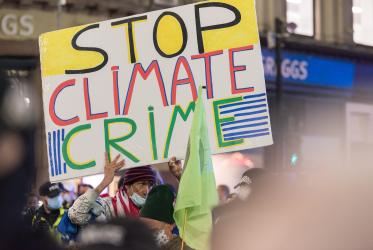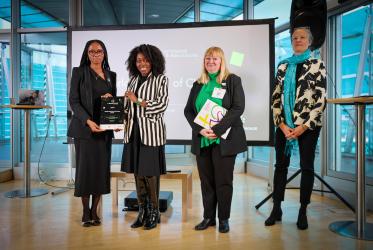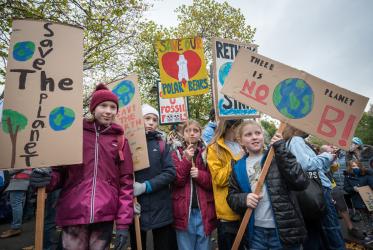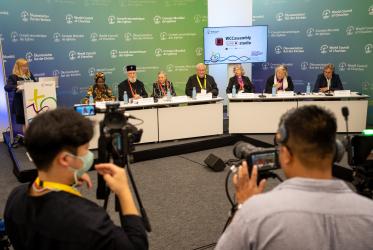Promoting children’s rights necessarily involves creating platforms for children to speak up, and for their concerns to be heard. It also involves ensuring that children and their families have access to relevant and easily understood information, as well as building the communication skills of children so that they can defend and exercise their rights.
The World Association for Christian Communication (WACC) was happy to participated in “A Stronger Voice for Children’s Rights,” a seminar organized by the World Council of Churches and UNICEF in the context of their new global partnership. WACC is an ecumenical global specialized agency/ministry in the area of communication for social change. Our work draws on the concept of communication rights: we believe that everyone has the right to communicate and to be communicated to, in the same way that they have the right to food, shelter, and security.
WACC welcomes the alliance between the WCC and UNICEF. This partnership creates an opportunity to discuss the role of churches and faith-based organizations beyond the confines of the church, about the ways in which churches can create and strengthen communities.
From WACC’s perspective, there is a strong connection between communication rights and children’s rights. In essence, children’s rights cannot be fully attained without taking into account the communication dimension of such rights. The following are a few examples of such link:
- Accessing information. Children, parents, and local communities need to have access to information about children’s rights and about the mechanisms to ensure children are able to exercise their rights. That information needs to be easily accessible, be made available in forms that are easily understandable, and in the appropriate language. Such information also has to be disseminated via appropriate communication platforms.
- Ensuring the right of children to have a voice, be listened to, and be taken seriously. Children need to be given the opportunity to express themselves about the issues they face and about their rights. This requires building the communication capacity of children and providing them with appropriate communication platforms so they can reach decision makers. It also entails a commitment on the part of those in positions of authority to listen.
- Promoting broad awareness of children’s rights. There is a need for a discussion on the rights of children. In many contexts, people are unaware of the fact that children have rights and that their rights must be respected. The media, both private, public, and community-based, can play a very significant role in creating broad discussions on children’s rights and calling for accountability.
- Protecting the cultural and language rights of children. Children have a right to access education, social services, and media in their own language, and for their culture to be respected. They also have a right to learn their mother tongues and to be educated in the culture of the country of their birth.
- Upholding the right of children to express their own spirituality. Children have their own ways to express their spirituality. They should have the right to express it. WACC sees communication as a spiritual experience, so the right for children to express their spirituality is also part of a universal ethic that includes the sacredness of life, truth-telling, compassion, and the “Golden Rule”.
- Media monitoring: Media have a big impact on the ways in which children are seen in different societies. It is important to monitor and examine media discourses to ensure they contribute to a social climate that contributes to the attainment of children’s rights.
All of these examples are in line with the UN Convention on the Rights of the Child, particularly with Article 4 (Protection of rights), Article 8 (Preservation of identity), Article 12 (Respect for the views of the child), Article 13 (Freedom of expression), Article 14 (Freedom of thought, conscience and religion), Article 15 (Freedom of association), Article 16 (Right to privacy), Article 17 (Access to information; mass media), Article 30 (Children of minorities/indigenous groups), and Article 42 (Knowledge of rights). In other words, the Convention already recognizes the communication rights of children.
In this light, WACC believes that the principles underlining the partnership between the WCC and UNICEF should also recognize that the attainment of children’s rights is inextricably linked to the attainment of their communication rights.
In WACC’s experience, there are two main ways in which we can all start promoting the communication rights of children as a way to ensure that their broader rights are respected:
- Supporting children-led media initiatives focused on children’s rights. These can be very powerful mechanisms to give children a voice at the local level, help them to understand their rights, build their communication skills, strengthen their culture and language, develop media literacy, and allow them to access key information. These initiatives can help make participating children become active citizens able to demand accountability from public officials, create awareness about their own rights, and work together to protect themselves from harm.
- Conducting media monitoring on the depiction of children in mainstream media. Having reliable data about the ways in which children are depicted is important to advocate for media that uphold and respect children’s rights. Conducting media monitoring focused on depictions of children in the news and other content can be an important mechanism to generate new data and push for change.
WACC looks forward to collaborating with the World Council of Churches and UNICEF on their new partnership.






